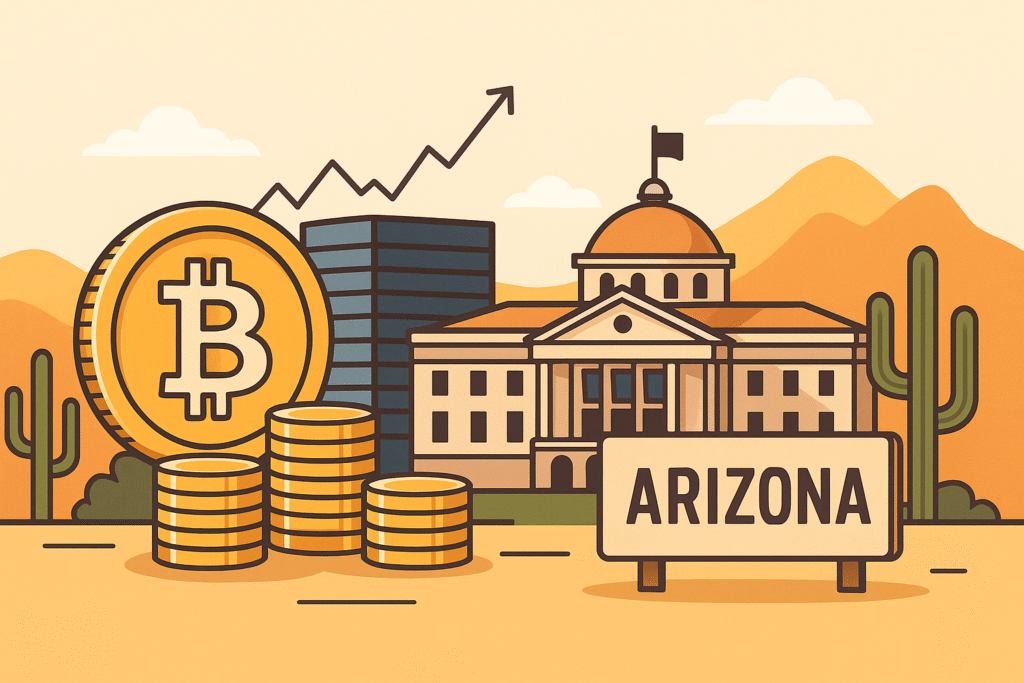Bitcoin adoption is no longer confined to tech companies or financial institutions. Increasingly, governments and states are recognising Bitcoin’s role as a strategic asset.
Recent developments in the United States have reaffirmed this trend, where Bitcoin is beginning to transition from a speculative investment to a financial pillar for long-term resilience.
This growing legitimacy could reshape how Bitcoin is viewed globally, laying the foundation for a broader, more sustainable adoption across sectors.
Arizona’s Strategic Bitcoin Reserve: A New Chapter for Government Adoption
Arizona has made history by becoming the first American state to pass legislation for a Strategic Bitcoin Reserve.
On 29 April 2025, the Arizona House of Representatives approved Senate Bill 1025 by a 31-25 margin, paving the way for the state to allocate up to 10% of its public funds to Bitcoin each year.
The move signals a profound shift in how governments might approach economic security in a world increasingly shaped by inflation and global instability.
While the bill still awaits Governor Katie Hobbs’ final signature, its passage through both chambers is a significant milestone. Despite some political friction unrelated to the Bitcoin initiative, the momentum around the reserve proposal is difficult to ignore.
Advocates such as Dennis Porter from the Satoshi Action Fund have called on other states to follow Arizona’s lead, framing Bitcoin reserves as an essential safeguard for future financial stability.
This development arrives at a time when broader attitudes toward Bitcoin in the United States are shifting. With growing support from the incoming Trump administration for digital assets, the regulatory environment appears set to become more favourable.
A state officially holding Bitcoin in its treasury sends a strong message: Bitcoin is no longer seen merely as an alternative asset but as a legitimate component of strategic financial planning.
The market itself responded positively, with Bitcoin maintaining a firm position around the $94,000 mark. While some natural resistance is expected around higher price points, the overall trend reflects a strengthening belief in Bitcoin’s long-term prospects.
The Arizona move could very well encourage other states to initiate similar strategies, creating a new layer of adoption that extends far beyond the private sector.
Strategy’s Expanding Bitcoin Holdings
At the same time as Arizona’s breakthrough, the corporate world continues to demonstrate its conviction in Bitcoin’s future. Strategy, led by Michael Saylor, announced another significant acquisition, purchasing an additional 15,355 Bitcoin for approximately $1.42 billion. This brings Strategy’s total holdings to 553,555 Bitcoin, valued at nearly $38 billion.
What is particularly striking is not just the size of this purchase but what it represents. Since Strategy’s initial foray into Bitcoin in 2020, institutional confidence in Bitcoin has steadily grown.
Each new acquisition reinforces the idea that Bitcoin is not a fleeting trend but an asset increasingly seen as a core treasury reserve. Strategy’s bold moves have effectively set a new precedent, encouraging a broader wave of institutional adoption.
Michael Saylor’s recent comments underscore this belief. He suggested that once mainstream financial institutions fully embrace Bitcoin, demand will surge to levels that make it increasingly scarce and difficult to acquire.
His optimism was echoed by the broader market, where Bitcoin has been gradually moving higher, supported by stronger hands willing to hold for the long term rather than speculate on short-term price movements.
Adding to the optimistic backdrop, the newly appointed SEC Chair, Paul Atkins, is expected to bring a more balanced and principled approach to digital asset regulation.
His own reported personal investments in cryptocurrencies suggest a deeper understanding of the sector’s potential. This shift in regulatory sentiment, combined with strong institutional participation, creates a promising foundation for Bitcoin’s continued integration into traditional finance.
While minor price fluctuations around key areas such as $98,300 are to be expected, the broader narrative remains distinctly bullish.
Bitcoin’s resilience amidst shifting macroeconomic conditions, coupled with tangible steps from states like Arizona and institutions like Strategy, paints an encouraging picture for the future. Bitcoin’s role as a strategic asset is only growing stronger.
Conclusion
The developments in Arizona and the latest acquisitions by Strategy represent more than isolated events, they are part of a broader trend of maturing adoption.
As Bitcoin steadily becomes a component of public finance strategies and corporate treasuries, its position in the global financial system strengthens.
Rather than being viewed solely as a volatile asset, Bitcoin is increasingly recognised for its ability to preserve value and enhance financial resilience.
With state governments, institutions, and a more supportive regulatory climate converging, the outlook for Bitcoin appears increasingly bright. The foundation for long-term growth is being laid, one strategic move at a time.

